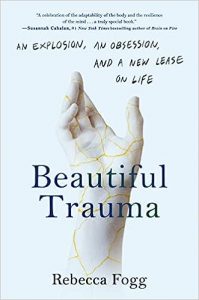On Writing Beautiful Trauma By Rebecca Fogg
On Writing Beautiful Trauma
By Rebecca Fogg
 In 2006, my right hand was partially amputated when the toilet exploded in my Brooklyn apartment, as I stood brushing my teeth before bed. With great difficulty I stopped the bleeding and called an ambulance, and surgeons at Bellevue Hospital “replanted” my hand the next day. On the anniversary of the accident, I celebrated my phenomenal recovery with a houseful of loved ones.
In 2006, my right hand was partially amputated when the toilet exploded in my Brooklyn apartment, as I stood brushing my teeth before bed. With great difficulty I stopped the bleeding and called an ambulance, and surgeons at Bellevue Hospital “replanted” my hand the next day. On the anniversary of the accident, I celebrated my phenomenal recovery with a houseful of loved ones.
Then, I confronted a new fright: normalcy. I had changed, but my life had not–same job, same social life, same home (new toilet)–and I couldn’t stand the dissonance. The accident had opened up new ways of seeing myself and the world, and I needed to continue exploring them. So I took a writing class.
Not surprisingly, all I could write about was the accident, and the account I wrote formed the beginnings of BEAUTIFUL TRAUMA. I later chose to incorporate the science of trauma because I found it astonishing and hopeful, and learning about it during recovery had proved crucial to my psychological healing. So, the book toggles between a chronological telling of my year of recovery, and chapters describing the science behind different phases of recovery.
While the structure sings now, hammering it out was one of the most challenging aspects of the process. I settled on a chronological telling of the memoir content because that’s how the story had gushed out of me in the writing class, and it worked. But then I still had to decide where it should start. In order to fully understand the accident’s impact, readers would need to know about my life and self before it; so I tried to cover that in a preface. But it was boringly unspecific, and then you’d get to the accident scene right after and think, “Why didn’t we just start here?” I also realized I could drop breadcrumbs about my personal history throughout subsequent chapters. Thus the exploding toilet muscled its way into the opening chapter.
Another big structural question was how to cover the science side of the story. I considered integrating it into the memoir content, as brief asides told by my present-day self. But that would mean constantly dragging the reader out of the action for a “lesson,” and making the science harder to understand by serving it in tiny fragments rather than complete and cohesive explanations.
Consolidating the science into its own chapters precluded those problems, and allowed me to write those chapters in their own more roaming, playful and nerdy tone and style. It also enabled me to use both present and past tense, so I could both reflect on my recovery days, and speak with present-day knowledge and perspective; whereas in the memoir chapters I was constraining myself to the present tense to bring readers into the moment with me.
As for what science to include, I followed my curiosity. Why didn’t I feel fear until paramedics arrived, and pain until I reached the hospital? How is it possible that I dodged PTSD? Then I searched for answers in popular science books, academic papers and medical texts, and by interviewing scores of subject-matter experts who generously dedicated hours of time to my edification.
I resolved not to mimic the voice of a science expert–because I’m not one, and also I wanted to present that content in a way that only I, the owner of that uniquely injured body, could; to suffuse it with wonder, lively imagery, and personal anecdote. One way I discovered to do this was to loosely structure each science chapter around a particular facet of the phenomenon I was describing; another was to use analogies to make the science more relatable. For instance, the chapter about hand rehabilitation emphasizes that the process isn’t about returning to your pre-accident state, it’s about learning how to maneuver your changed body so you can thrive again. And I used the analogy of learning to play a musical instrument to explain how the brain learns to operate a changed body.
These big decisions made up front (more or less), the rest of my process was trial and error: writing down blind alleys to see where, if anyplace, they led; trying on hooks and tones like hats; reminding myself to “show” not “tell”; constantly cutting and distilling to wring more impact out of fewer words. When I found myself thrashing about in the proverbial weeds, I’d ask, “What is it that I find most interesting about this [topic, scene, person]?” Whatever “it” was became a beacon leading me back to navigable waters.
If this sounds impossibly organized and efficient, it’s because I am articulating it with the knowledge of what ultimately worked. But what didn’t work is as much a part of Beautiful Trauma’s origin story as what did. This book occupied my head and heart for over a decade, during which period I never stopped noodling over ideas and problems in my mind, on paper, on screen and occasionally in conversation, until the day I submitted final copy edits.
So I suppose I could summarize my process as equal measures of analytical thinking/planning, and blindly rooting around in the glorious (and occasionally torturous) muck of ideas, until I believe I have conveyed something of value to the reader. While every writer’s process is unique, I hope that sharing some of mine will help others craft the story that only they can tell.
—
In 2008, Rebecca Fogg walked away from her New York life and successful career in financial services to move to London, where she co-founded the Institute of Pre-Hospital Care at London’s Air Ambulance and continues to work, write, and learn Scottish fiddle. A graduate of Yale University and The Harvard Business School, she spent five years (2014-2019) researching and writing about healthcare with renowned Harvard Professor Clayton Christensen, author of The Theory of Disruptive Innovation. BEAUTIFUL TRAUMA: An Explosion, an Obsession, and a New Leases on Life (Avery, Penguin Random House), is Fogg’s first book. It was awarded the 1029 Royal Society of Literature Giles St. Aubyn Judge’s Special Commendation for work in progress.
Follow her on Twitter @RebFogg
BEAUTIFUL TRAUMA
 A compelling account of surviving a freak accident, and a fascinating exploration of the science of trauma and recovery.
A compelling account of surviving a freak accident, and a fascinating exploration of the science of trauma and recovery.
Late one night, while Rebecca Fogg was alone in her apartment, her hand was partially amputated in an explosion. Quick thinking saved her life, but the journey to recovery would be a slow one. As the doctors rebuilt her hand, Rebecca (who also survived 9/11) began rebuilding her sense of self by studying the physical and psychological process of recovery.
Interspersing the personal with the medical, Rebecca charts her year of rehabilitation, touching on the marvelously adaptable anatomy of the hand; how the brain’s fight-or-flight mechanism enables us to react instantly to danger; and why trauma causes some people to develop PTSD and gives others a whole new lease on life.
Told with emotional and intellectual clarity, Beautiful Trauma is a celebration of the resilience of the human spirit and the wonder of the human hand.
BUY HERE
Category: How To and Tips

























